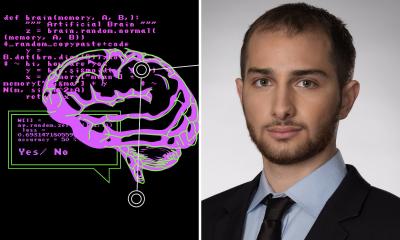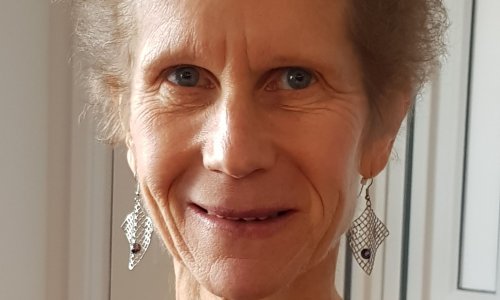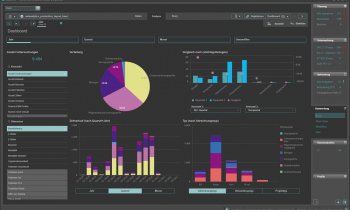Image source: Shutterstock/Sashkin
Article • Cryptography potential
Harnessing the benefits of blockchain to enhance care
Blockchain is a concept that could have significant benefits for healthcare – particularly in radiology – but several challenges remain.
Report: Mark Nicholls
Although an effective conduit through which to share data and medical images, particularly across health systems, one drawback is speed, given the amount of data that can be involved. However, Professor Morgan McBee, paediatric radiologist and imaging informaticist, believes blockchain advantages mean harnessing its potential within a medical context is worthwhile.

A blockchain is a growing list of records linked by using cryptography, and as a distributed ledger, can record transactions between two parties efficiently and in a verifiable and permanent way. ‘As blockchain is an immutable distributed ledger technology, the most obvious application in healthcare is medical records, including medical imaging data,’ McBee explained.
The lack of a single-payer healthcare system in the USA, for example, means that individual healthcare systems and hospitals control their own electronic medical records – with little data sharing. McBee described the following scenario: a cancer patient living in Minnesota for six months, and Florida for the next six, has two healthcare systems that can view each other’s medical records and radiology reports, yet radiologists and other healthcare providers cannot see images performed at the other system. Whenever she has a scan at one hospital, this patient must either have them burn a disc and then transport it herself, or mail it, or have the images sent electronically so that two different healthcare systems have access to the other’s imaging data. ‘If she could store the images in a distributed ledger, such as blockchain, or control access to the images stored in a cloud environment via a distributed ledger, she could grant access for one healthcare system to imaging performed at the other, thus obviating the need for her to manually carry discs or manually push images electronically.’
Seen in action
This scenario is not confined to the USA, he pointed out. The ability to share medical imaging data across Europe can enable more robust research, artificial intelligence, and the ability for patients to control their own medical records to bolster compliance with the General Data Protection Regulation (GDPR). ‘Specific to medical imaging,’ he added, ‘blockchain can be used for image sharing to include patient-ownership of their own images, tracking of medical devices, research, teleradiology and artificial intelligence.’ Other more general use examples in healthcare include medical records, other supply chain management, billing, and credential verifying.
A blockchain implementation that enabled patient-ownership of medical images could be used directly by a patient, and anyone they grant access to, such as family members or healthcare providers. ‘A blockchain implementation for credentialing could be used by hospital administrators to have faster and trustworthy verification of physicians’ credentials,’ he added
Recommended article

Article • Data handling
Blockchain: “Hype will fade but the technology will remain”
A new dimension in data handling is not only emerging, but is already a reality in our lives. However, political discourse about this often lags behind real events. We spoke with two experts who have an overview of clouds, decentralised data flows and the evaluation of personal data with IT help in various areas. Engineer Professor Alexandra Dmitrienko is a Secure Software Systems expert at the…
Data provenance
‘It is immutable and therefore data can only be added and not removed. Once added, data cannot be changed,’ McBee emphasised. ‘This is not to say that a medical record stored on a blockchain is static, but it means that you have a perfect record of every single thing that has been added all the way back to when the record was initially created, in a concept known as data provenance.’
Challenges remain, he said, but when viewed as a distributed ledger technology, blockchain can be a powerful tool. However, while one of blockchain’s strongest benefits is security, ‘it is also one of its biggest pitfalls.’ If a blockchain implementation is public (permission-less), the data is available for anyone on the network to view it, and while still secure and encrypted, any future vulnerabilities in the underlying encryption scheme could reveal sensitive medical information.
Access via private blockchains
Blockchain is definitely a viable solution for certain use cases, but it is far from a panacea and cannot solve all of our problems in healthcare
Morgan McBee
This risk can be mitigated through the use of private (permissioned) blockchains where only certain actors (hospitals, healthcare providers and patients) have access to the data.
Another challenge is speed, with blockchain being orders of magnitude slower than a traditional database, when dealing with large volumes of data and millions of patients. McBee also indicated that, with current blockchain technologies, storage of actual imaging data in a blockchain is unlikely. ‘Some of the concerns surrounding AI algorithms are that a ‘black box’ could be alleviated by blockchain. All data that algorithms are trained on can be tracked and verified, as can all outputs of the algorithms,’ he said. ‘Blockchain is definitely a viable solution for certain use cases, but it is far from a panacea and cannot solve all of our problems in healthcare,’ McBee concluded. ‘I think the biggest impact of blockchain on healthcare can be data sharing.’
Profile:
Professor Morgan McBee is a paediatric radiologist and imaging informaticist, as well as Assistant Professor of Radiology at the Medical University of South Carolina. He has leveraged his keen interest in IT throughout his radiology career to improve systems and patient care.
12.03.2020











